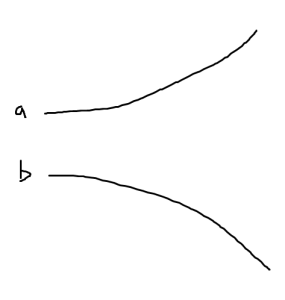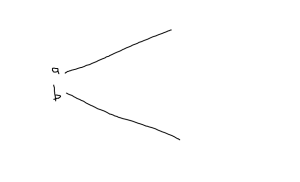[Click here for a PDF of this post with nicer formatting]
Q: two state Hamiltonian.
Given a two-state system
\begin{equation}\label{eqn:simplestTwoByTwoPerturbation:20}
H = H_0 + \lambda V
=
\begin{bmatrix}
E_1 & \lambda \Delta \\
\lambda \Delta & E_2
\end{bmatrix}
\end{equation}
- (a) Solve the system exactly.
- (b) Find the first order perturbed states and second order energy shifts, and compare to the exact solution.
- (c) Solve the degenerate case for \( E_1 = E_2 \), and compare to the exact solution.
A: part (a)
The energy eigenvalues \( \epsilon \) are given by
\begin{equation}\label{eqn:simplestTwoByTwoPerturbation:40}
0
=
\lr{ E_1 – \epsilon }
\lr{ E_2 – \epsilon }
– (\lambda \Delta)^2,
\end{equation}
or
\begin{equation}\label{eqn:simplestTwoByTwoPerturbation:60}
\epsilon^2 – \epsilon\lr{ E_1 + E_2 } + E_1 E_2 = (\lambda \Delta)^2.
\end{equation}
After rearranging this is
\begin{equation}\label{eqn:simplestTwoByTwoPerturbation:80}
\epsilon = \frac{ E_1 + E_2 }{2} \pm \sqrt{ \lr{ \frac{ E_1 – E_2 }{2} }^2 + (\lambda \Delta)^2 }.
\end{equation}
Notice that for \( E_2 = E_1 \) we have
\begin{equation}\label{eqn:simplestTwoByTwoPerturbation:100}
\epsilon = E_1 \pm \lambda \Delta.
\end{equation}
Since a change of basis can always put the problem in a form so that \( E_1 > E_2 \), let’s assume that to make an approximation of the energy eigenvalues for \( \Abs{\lambda \Delta} \ll \ifrac{ (E_1 – E_2) }{2} \)
\begin{equation}\label{eqn:simplestTwoByTwoPerturbation:120}
\begin{aligned}
\epsilon
&=
\frac{ E_1 + E_2 }{2} \pm \frac{ E_1 – E_2 }{2} \sqrt{ 1 + \frac{(2 \lambda \Delta)^2}{(E_1 – E_2)^2} } \\
&\approx
\frac{ E_1 + E_2 }{2} \pm \frac{ E_1 – E_2 }{2} \lr{ 1 + 2 \frac{(\lambda
\Delta)^2}{(E_1 – E_2)^2} } \\
&=
\frac{ E_1 + E_2 }{2} \pm \frac{ E_1 – E_2 }{2}
\pm
\frac{(\lambda \Delta)^2}{E_1 – E_2} \\
&=
E_1 + \frac{(\lambda \Delta)^2}{E_1 – E_2}, E_2 + \frac{(\lambda \Delta)^2}{E_2 – E_1}.
\end{aligned}
\end{equation}
For the perturbed states, starting with the plus case, if
\begin{equation}\label{eqn:simplestTwoByTwoPerturbation:140}
\ket{+} \propto
\begin{bmatrix}
a \\
b
\end{bmatrix},
\end{equation}
we must have
\begin{equation}\label{eqn:simplestTwoByTwoPerturbation:160}
\begin{aligned}
0
&=
\biglr{ E_1 – \lr{ E_1 + \frac{(\lambda \Delta)^2}{E_1 – E_2} } } a + \lambda
\Delta b \\
&=
\biglr{ – \frac{(\lambda \Delta)^2}{E_1 – E_2} } a + \lambda \Delta b,
\end{aligned}
\end{equation}
so
\begin{equation}\label{eqn:simplestTwoByTwoPerturbation:180}
\ket{+} \rightarrow
\begin{bmatrix}
1 \\
\frac{\lambda \Delta}{E_1 – E_2}
\end{bmatrix}
= \ket{+} + \frac{\lambda \Delta}{E_1 – E_2} \ket{-}.
\end{equation}
Similarly for the minus case we must have
\begin{equation}\label{eqn:simplestTwoByTwoPerturbation:200}
\begin{aligned}
0
&=
\lambda \Delta a + \biglr{ E_2 – \lr{ E_2 + \frac{(\lambda \Delta)^2}{E_2 – E_1} } } b \\
&=
\lambda \Delta b + \biglr{ – \frac{(\lambda \Delta)^2}{E_2 – E_1} } b,
\end{aligned}
\end{equation}
for
\begin{equation}\label{eqn:simplestTwoByTwoPerturbation:220}
\ket{-} \rightarrow
\ket{-} + \frac{\lambda \Delta}{E_2 – E_1} \ket{+}.
\end{equation}
A: part (b)
For the perturbation the first energy shift for perturbation of the \( \ket{+} \) state is
\begin{equation}\label{eqn:simplestTwoByTwoPerturbation:240}
\begin{aligned}
E_{+}^{(1)}
&= \ket{+} V \ket{+} \\
&=
\lambda \Delta
\begin{bmatrix}
1 & 0
\end{bmatrix}
\begin{bmatrix}
0 & 1 \\
1 & 0
\end{bmatrix}
\begin{bmatrix}
1 \\
0
\end{bmatrix} \\
&=
\lambda \Delta
\begin{bmatrix}
1 & 0
\end{bmatrix}
\begin{bmatrix}
0 \\
1
\end{bmatrix} \\
&=
0.
\end{aligned}
\end{equation}
The first order energy shift for the perturbation of the \( \ket{-} \) state is also zero. The perturbed \( \ket{+} \) state is
\begin{equation}\label{eqn:simplestTwoByTwoPerturbation:260}
\begin{aligned}
\ket{+}^{(1)}
&= \frac{\overline{{P}}_{+}}{E_1 – H_0} V \ket{+} \\
&= \frac{\ket{-}\bra{-}}{E_1 – E_2} V \ket{+}
\end{aligned}
\end{equation}
The numerator matrix element is
\begin{equation}\label{eqn:simplestTwoByTwoPerturbation:280}
\begin{aligned}
\bra{-} V \ket{+}
&=
\begin{bmatrix}
0 & 1
\end{bmatrix}
\begin{bmatrix}
0 & \Delta \\
\Delta & 0
\end{bmatrix}
\begin{bmatrix}
1 \\
0
\end{bmatrix} \\
&=
\begin{bmatrix}
0 & 1
\end{bmatrix}
\begin{bmatrix}
0 \\
\Delta
\end{bmatrix} \\
&=
\Delta,
\end{aligned}
\end{equation}
so
\begin{equation}\label{eqn:simplestTwoByTwoPerturbation:300}
\ket{+} \rightarrow \ket{+} + \ket{-} \frac{\Delta}{E_1 – E_2}.
\end{equation}
Observe that this matches the first order series expansion of the exact value above.
For the perturbation of \( \ket{-} \) we need the matrix element
\begin{equation}\label{eqn:simplestTwoByTwoPerturbation:320}
\begin{aligned}
\bra{+} V \ket{-}
&=
\begin{bmatrix}
1 & 0
\end{bmatrix}
\begin{bmatrix}
0 & \Delta \\
\Delta & 0
\end{bmatrix}
\begin{bmatrix}
0 \\
1
\end{bmatrix} \\
&=
\begin{bmatrix}
1 & 0
\end{bmatrix}
\begin{bmatrix}
\Delta \\
0 \\
\end{bmatrix} \\
&=
\Delta,
\end{aligned}
\end{equation}
so it’s clear that the perturbed ket is
\begin{equation}\label{eqn:simplestTwoByTwoPerturbation:340}
\ket{-} \rightarrow \ket{-} + \ket{+} \frac{\Delta}{E_2 – E_1},
\end{equation}
also matching the approximation found from the exact computation. The second order energy shifts can now be calculated
\begin{equation}\label{eqn:simplestTwoByTwoPerturbation:360}
\begin{aligned}
\bra{+} V \ket{+}’
&=
\begin{bmatrix}
1 & 0
\end{bmatrix}
\begin{bmatrix}
0 & \Delta \\
\Delta & 0
\end{bmatrix}
\begin{bmatrix}
1 \\
\frac{\Delta}{E_1 – E_2}
\end{bmatrix} \\
&=
\begin{bmatrix}
1 & 0
\end{bmatrix}
\begin{bmatrix}
\frac{\Delta^2}{E_1 – E_2} \\
\Delta
\end{bmatrix} \\
&=
\frac{\Delta^2}{E_1 – E_2},
\end{aligned}
\end{equation}
and
\begin{equation}\label{eqn:simplestTwoByTwoPerturbation:380}
\begin{aligned}
\bra{-} V \ket{-}’
&=
\begin{bmatrix}
0 & 1
\end{bmatrix}
\begin{bmatrix}
0 & \Delta \\
\Delta & 0
\end{bmatrix}
\begin{bmatrix}
\frac{\Delta}{E_2 – E_1} \\
1 \\
\end{bmatrix} \\
&=
\begin{bmatrix}
0 & 1
\end{bmatrix}
\begin{bmatrix}
\Delta \\
\frac{\Delta^2}{E_2 – E_1} \\
\end{bmatrix} \\
&=
\frac{\Delta^2}{E_2 – E_1},
\end{aligned}
\end{equation}
The energy perturbations are therefore
\begin{equation}\label{eqn:simplestTwoByTwoPerturbation:400}
\begin{aligned}
E_1 &\rightarrow E_1 + \frac{(\lambda \Delta)^2}{E_1 – E_2} \\
E_2 &\rightarrow E_2 + \frac{(\lambda \Delta)^2}{E_2 – E_1}.
\end{aligned}
\end{equation}
This is what we had by approximating the exact case.
A: part (c)
For the \( E_2 = E_1 \) case, we’ll have to diagonalize the perturbation potential. That is
\begin{equation}\label{eqn:simplestTwoByTwoPerturbation:420}
\begin{aligned}
V &= U \bigwedge U^\dagger \\
\bigwedge &=
\begin{bmatrix}
\Delta & 0 \\
0 & -\Delta
\end{bmatrix} \\
U &= U^\dagger = \inv{\sqrt{2}}
\begin{bmatrix}
1 & 1 \\
1 & -1
\end{bmatrix}.
\end{aligned}
\end{equation}
A change of basis for the Hamiltonian is
\begin{equation}\label{eqn:simplestTwoByTwoPerturbation:440}
\begin{aligned}
H’
&=
U^\dagger H U \\
&=
U^\dagger H_0 U + \lambda U^\dagger V U \\
&=
E_1 U^\dagger + \lambda U^\dagger V U \\
&=
H_0 + \lambda \bigwedge.
\end{aligned}
\end{equation}
We can now calculate the perturbation energy with respect to the new basis, say \( \setlr{ \ket{1}, \ket{2} } \). Those energy shifts are
\begin{equation}\label{eqn:simplestTwoByTwoPerturbation:460}
\begin{aligned}
\Delta^{(1)} &= \bra{1} V \ket{1} = \Delta \\
\Delta^{(2)} &= \bra{2} V \ket{2} = -\Delta.
\end{aligned}
\end{equation}
The perturbed energies are therefore
\begin{equation}\label{eqn:simplestTwoByTwoPerturbation:480}
\begin{aligned}
E_1 &\rightarrow E_1 + \lambda \Delta \\
E_2 &\rightarrow E_2 – \lambda \Delta,
\end{aligned}
\end{equation}
which matches \ref{eqn:simplestTwoByTwoPerturbation:100}, the exact result.

